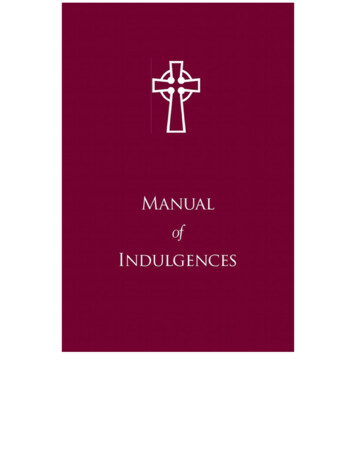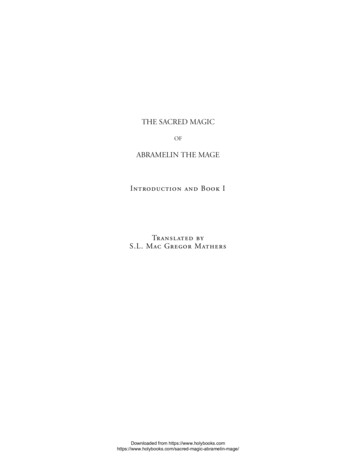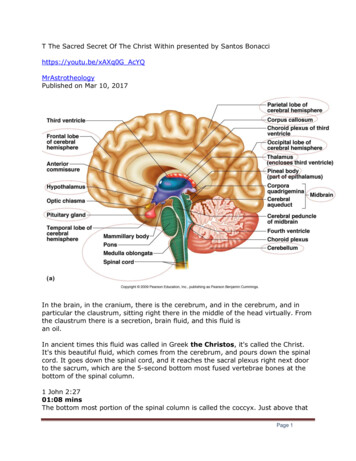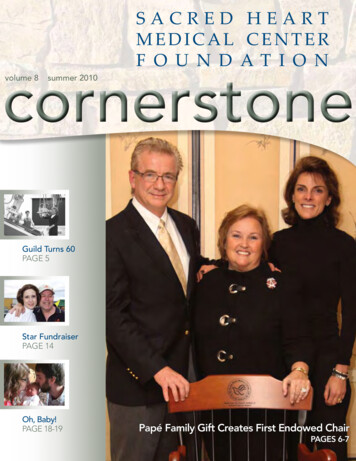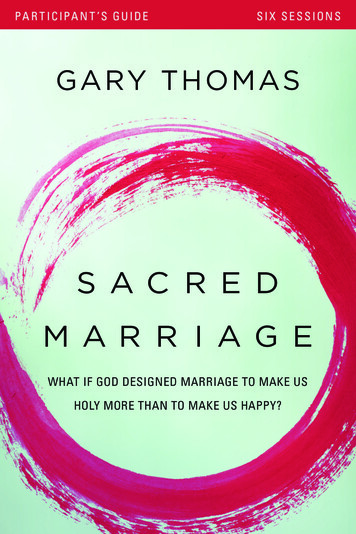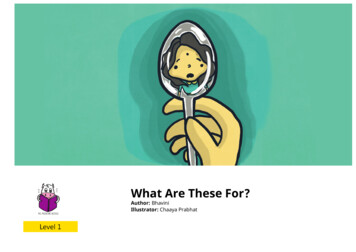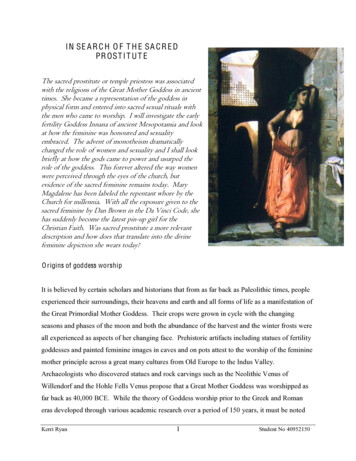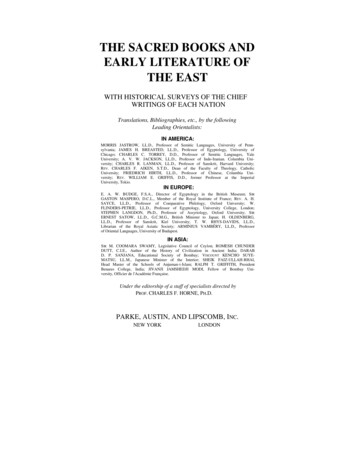
Transcription
THE SACRED BOOKS ANDEARLY LITERATURE OFTHE EASTWITH HISTORICAL SURVEYS OF THE CHIEFWRITINGS OF EACH NATIONTranslations, Bibliographies, etc., by the followingLeading Orientalists:IN AMERICA:MORRIS JASTROW, LL.D., Professor of Semitic Languages, University of Pennsylvania; JAMES H. BREASTED, LL.D., Professor of Egyptology, University ofChicago; CHARLES C. TORREY, D.D., Professor of Semitic Languages, YaleUniversity; A. V. W. JACKSON, LL.D., Professor of Indo-Iranian. Columbia University; CHARLES R. LANMAN, LL.D., Professor of Sanskrit, Harvard University;REV. CHARLES F. AIKEN, S.T.D., Dean of the Faculty of Theology, CatholicUniversity; FRIEDRICH HIRTH, LL.D., Professor of Chinese, Columbia University; REV. WILLIAM E. GRIFFIS, D.D., former Professor at the ImperialUniversity, Tokio.IN EUROPE:E. A. W. BUDGE, F.S.A., Director of Egyptology in the British Museum; SIRGASTON MASPERO, D.C.L., Member of the Royal Institute of France; REV. A. H.SAYCE, LL.D., Professor of Comparative Philology, Oxford University; W.FLINDERS-PETRIE, LL.D., Professor of Egyptology, University College, London;STEPHEN LANGDON, Ph.D., Professor of Assyriology, Oxford University; SIRERNEST SATOW, LL.D., G.C.M.G., British Minister to Japan; H. OLDENBERG,LL.D., Professor of Sanskrit, Kiel University; T. W. RHYS-DAVIDS, LL.D.,Librarian of the Royal Asiatic Society; ARMINIUS VAMBÉRY, LL.D., Professorof Oriental Languages, University of Budapest.IN ASIA:SIR M. COOMARA SWAMY, Legislative Council of Ceylon; ROMESH CHUNDERDUTT, C.I.E., Author of the History of Civilization in Ancient India; DARABD. P. SANJANA, Educational Society of Bombay; VISCOUNT KENCHO SUYEMATSU, LL.M., Japanese Minister of the Interior; SHEIK FAIZ-ULLAH-BHAI,Head Master of the Schools of Anjuman-i-Islam; RALPH T. GRIFFITH, PresidentBenares College, India; JIVANJI JAMSHEDJI MODI, Fellow of Bombay University, Officier de l'Académie Française.Under the editorship of a staff of specialists directed byPROF. CHARLES F. HORNE, PH.D.PARKE, AUSTIN, AND LIPSCOMB, INC.NEW YORKLONDON
This Volume is one of a complete set of the Sacred Booksand Early Literature of the East, consisting of fourteenvolumes. In Volume I of the series will be found a certificate as to the limitation of the edition and the registerednumber of this set.Copyright, 1917,Parke, Austin, and Lipscomb, Inc.
THE ROCK TEMPLE OF ABU-SIMBEL.Showing the secret Holy Place in the rear.
UNDERWOOD & UNDERWOOD, N.Y.
THE SACRED BOOKS AND EARLYLITERATURE OF THE EAST———VOLUME IIEGYPT———In Translations byJAMES H. BREASTED, LL.D., Professor of Egyptology in the University of Chicago; E. A. W. BUDGE, F.S.A., Director of Egyptologyin the British Museum; SIR GASTON MASPERO, D.C.L., Member ofthe Royal Institute of France; REV. A. H. SAYCE, LL.D., Professorof Comparative Philology at Oxford University; ALLAN H. GARDINER, Litt.D., Editor of the Journal of Egyptian Archaeology;W. FLINDERS-PETRIE, LL.D., Professor of Egyptology in UniversityCollege, London; and other leading Egyptologists.With a Brief Bibliography byPROF. JAMES H. BREASTED, LL.D.—————With an Historical Survey and Descriptions byPROF. CHARLES F. HORNE, PH.D.PARKE, AUSTIN, AND LIPSCOMB, INC.NEW YORKLONDON
"Let there be light."—GENESIS I, 3.———"There never was a false god, nor was there everreally a false religion, unless you call a child afalse man."—MAX MÜLLER.
CONTENTS OF VOLUME II———————EGYPTPAGEINTRODUCTION — Man's First Hope of Immortalityand the Dawning of the Critic Sense .3THE ANCIENT EMPIRE (3500 B.C-2475 B.C.)I.—THE EARLIEST EGYPTIAN REMAINS .The Boast of Methen, the First Autobiography(3000 B.C.) .The Palermo Stone, Egypt's First HistoricalRecord (2750 B.C.) . .15II.—THE SECRET PYRAMID TEXTS (2625 B.C.) .23III.—BIOGRAPHY, TRAVEL, AND ROMANCE .The Words of Uni, the King's Friend (2550 B.C.) .Inscriptions of Harkhuf, the First Explorer(2525 B.C.) .Tales of the Magicians, Earth's Earliest Stories(2000 or 3000 B.C.).3537IV.—THE PRECEPTS OF PTAH-HOTEP (2700 B.C.?),The Oldest Book in the World .1317434862THE MIDDLE EMPIRE (2500 B.C-1600 B.C.)V.—RELIGIOUS AND SEMI-HISTORIC TEXTS . 81The "Coffin Texts". 84A Mother's Charm against Evil Spirits . 86The First Poem of Pessimism. 87Songs of the Harper. 89The First Misanthrope . 92The Tomb Record of Baron Ameni . 97Counsels of King Intef (2100 B.C.?) . 98Counsel of King Amenemhet (1970 B.C.) . 108v
viCONTENTSPAGEVI.—TALES OF ROMANCE AND TRAVEL .113The Eloquent Peasant, the First Study ofRhetoric .The Shipwrecked Sailor .Memoirs of Sinuhit .Fragments of the Earliest Ghost-Story .115133138149VII.—THE BOOK OF THE DEAD, Egypt's Holy Scripture. .157THE GREAT EMPIRE (1600 B.C-525 B.C.)VIII.—HYMNS TO THE ONE UNIVERSAL GOD .289To Aton, the Creator .The King's Own Hymn . .Hymn to Re as Sole God.Hymn to the Nile.291296298300IX.—THE RELIGION OF THE POOR IN ANCIENT EGYPTPrayers for Mercy .309X.—HISTORY AND LEGEND UNDER THE GREAT EMPIRE.327The Expulsion of the Shepherd Kings . . .Annals of Thutmose III, the Egyptian WorldConqueror (1500 B.C.).Biography of a Soldier Under Thutmose III ."The Taking of Joppa," Legend of a StratagemUnder Thutmose.The Building Record of a Pharaoh .330332340344350XL—EGYPT'S CHIEF EPIC POEM (1287 B.C.) .359The Triumph of Rameses II, by Penta-our .361XII.—TALES OF ROMANCE AND TRAVEL .379The Two Brothers, Egypt's Best-known Story .The Doomed Prince.Travels of Unamunu in Syria .381392400
CONTENTSviiTHE AGE OF WEAKNESS (525 B.C.——A.D.)PAGEXIII.—THE BOOK OF THE BREATHS OF LIFE, The SecretTeaching of the Egyptian Priesthood .414XIV.—ROMANCES .The Princess Possessed by a Demon, The OldestLiterary Forgery . .Prince Satni and the Magic Book .425427431BIBLIOGRAPHY.455
ILLUSTRATIONS IN VOLUME II—————————FACING PAGEThe Rock Temple of Abu-Simbel . FrontispieceThe Creation.32Ptah Fashioning the Egg of the World .48Osiris, King of the World of Death .64Isis, Wife of Osiris .96Khepera, the Beetle-god of Resurrection . 144A Page from the Book of the Dead . 160Anubis, the Guide through the Underworld . 208Hathor Emerges from the Mountain of Tombs . 240Horus, the God-child, Rising from the Lotus . 272Nut, the World Mother . 320Thoth, the Chief Friend of Man . 416ix
"Be not arrogant because of that which thou knowest; dealwith the ignorant as with the learned; for the barriers of artare not closed, no artist being in possession of the perfection towhich he aspires."—FROM THE EGYPTIANKNOWN TEACHER.BOOKOFPTAH-HOTEP,EARTH'SEARLIEST-
SACRED BOOKS AND EARLY LITERATUREOFEGYPT————INTRODUCTIONMAN'S FIRST HOPE OF IMMORTALITY AND THE DAWNING OFTHE CRITIC SENSETHE stupendous fact which makes Egyptian literaturemost worth our reading is that in Egypt mankind firstsoared to splendid heights of religious thought. There, so faras we now know, earnest and able men first faced with profound intellectual meditation the spiritual problems of thisworld. There the mass of men, for the first time, arrangedtheir earthly lives upon a firm-set confidence that there was alife beyond.The civilization of Egypt may possibly be as ancient as thatof Babylonia. Recent scholars incline to regard that of Babylonia as the older of the two, and the other as perhaps an offshoot from it; but in that case the younger branch outgrewthe parent in both wisdom and culture. Perhaps the swifterblossoming of Egyptian thought — if we may call a progressswift when it extended over unknown thousands of years —was due to the more secluded character of Egypt's situation.There and in Babylonia were two great rivers, the Nile andthe Euphrates, whose vast and fertile valleys were fitted byNature to be the seat of men's easiest development. But theEuphrates valley was exposed to warlike attack from everyside. Again and again the Babylonian civilization was overthrown by hordes of invading barbarians. New kingdomsrose only on the ruins of the old; and war remained ever thechief business and chief thought of life. In Egypt, on the3
4THE SACRED BOOKScontrary, the Nile valley was marvelously sheltered from attack by the spreading deserts on every side. It is true thatduring Egypt's early history we twice find her invaded andpartly conquered by foreign hosts; but in each case she finallydrove out the invaders. Moreover, these invasions occurredat intervals of over a thousand years. Thus the Egyptianswere left, far more than any other nation in the world, to workout their own destinies, to build up their own civilization —in peace.The history of Egypt before the days of Rome is dividedinto four clearly marked periods. The chronology of thefirst of these is still a puzzle to our scholars, though veryrecent criticism is establishing an outline of dates which mayprove fairly accurate. According to this, our oldest definiteEgyptian date sets Khufu, or Cheops, as building the greatestof the pyramids about 3000 B.C.1 Khufu ruled in what iscalled the Fourth Dynasty of kings; so King Menes, who isregarded as the founder of the First Dynasty; that is, as thefirst ruler to gather all Egypt into a single Empire, musthave lived about 3400 B.C. Back of Menes there is an older,uncountable age of lesser kingdoms and slowly developingcivilization. Forward from his day extends the period ofthe first or what we now call the "Ancient " Egyptian Empire, which he founded. This was ruled by the six earliestdynasties of kings, and lasted for almost a thousand years; farlonger, that is, than the later and better known world-empireof Rome was able to maintain itself.The earliest literary remains of Egypt come down to usfrom the closing years of this "Ancient Empire." They arethe hieroglyphics inscribed on the inner walls of pyramids,which were the giant tombs of kings, or sometimes on thelesser tombs of high officials. Some rough-carved, barelyreadable names survive on even earlier tombs, dating fromMenes or from lesser kings before him.But Egyptian litera1The date of Khufu's reign, and all dates of the Ancient and MiddleEmpire are, by some scholars, set back about fifteen hundred yearsearlier. The evidence is inconclusive, but seems to favor the laterdate.
LITERATURE OF THE EAST5ture, in the sense of many connected phrases making a fulldocument, bursts upon us, as it were, suddenly and startlinglyin a completed form within the pyramid tombs of King Unis,of the Fifth Dynasty, and his successors of the Sixth. Thesecret rooms within these pyramids preserved the solemnlyimpressive ancient writings, sheltered them through long agesfrom all the ruin elsewhere wrought by Nature and by man.The secret of these pyramids was not penetrated, and theirancient picture-writing found, until 1880. So that the studyof these texts, and all they have taught us of the growth ofreligious thought in Egypt, is very recent. They are calledthe "Pyramid Texts" and the most important of them aregiven in our present volume.These Pyramid Texts are wholly religious. They continue echoing in a thousand different forms one central religious thought. The dead king has gone on to a life beyond,has become a god among the gods. As yet the inscriptionsdo not follow this thought of immortality beyond the king.There is no assertion that other men live beyond death;and in the slight remains of this period gathered from sourcesoutside the pyramids there is no evidence of such a belief.The other literary remnants from the Old Empire arechiefly biographical, the boastful account of some high official who, building his own tomb during his lifetime, recordshis proud successes on the pictured walls. Then there is onetruly remarkable historical fragment, a carven stone nowpreserved in an Italian museum at Palermo, and hence calledthe "Palermo stone." This gives us a list of ancient kingsand some note of the events occurring during their reigns. Itis, however, so worn and broken that the record gleaned fromit is almost hopelessly fragmentary.In our reprinted documents from this ancient and almostforgotten kingdom we have included one other; not this timea fragment painted or carved on stone, but a real book ormanuscript, written on papyrus, the plant which the Egyptians learned to make into the most ancient sort of paper.This genuine, early book is not really of the Old Empire;it belongs to the next period. But the writer then recorded
6THE SACRED BOOKSan ancient tale, or rather a collection called "The Tales ofthe Magicians." The manuscript dates apparently fromabout the year 2000 B.C.; that is, from the Twelfth Dynasty,but the stories it tells are of King Khufu and his predecessors,and so reach back yet another thousand years for the picturesthat they offer. So crude and simple are the tales, so manifestly dealing with a still childish and uncritical audience,that we feel justified in referring their origin to the AncientEmpire of which they tell, and so calling them the "oldeststories in the world."This first "Old Empire" of Egypt seems to have been overthrown by a foreign invasion, and there were centuries ofdisorder, but the Egyptian princes or great lords were neverwholly overthrown and gradually they reestablished theirsupremacy in a sort of "feudal period," or rule of the barons.Over these one king was again set up; and a second periodof peaceful splendor ensued about the year 200 under the greatTwelfth Dynasty of emperors, or Pharaohs.From this "Middle Empire" or feudal period the surviving texts are fairly numerous. There is another papyrusmanuscript, The Precepts of Ptah-hotep, which disputes withthe Tales of the Magicians the rank of "oldest book" in theworld. There are other similar studies of wisdom or booksof good counsel, perhaps the most interesting of them beingthat of King Intef to his son. The surviving manuscript ofthis is of much later date, but King Intef was of the EleventhDynasty, and the original set of "counsels" must have beenalmost as old.Far more interesting than these books of counsel are thereligious texts surviving from the Middle Empire. Of these,commonly called the "Coffin Texts," the most striking aregiven in our volume. We have not from this age any onegreat religious collection like the Pyramid Texts, but theCoffin Texts cover a much wider range. They are the hieroglyphs, usually in verse form, carved upon the coffins of thedead. They are usually brief, but they speak not merely forkings but for all classes of society. They teach us that theidea of life beyond life had now become universal. But
LITERATURE OF THE EAST7mingled with it is a growing cynicism. Some of these textsassert a confident and even arrogant assurance of the future;others breathe a gentle sadness, a feeling that this life by itself is of little worth, while the promise of the one beyondis very doubtful.Among the other pieces surviving there is one of peculiarinterest in that it offers us man's earliest study of rhetoric,of the art of words. It is a deliberate invention, not a legendor a myth, but a story invented by the rhetorician for the express purpose of displaying the beauty and the power ofspeech when handled as an art. We offer to the reader thiscurious beginning of conscious art, and also the earliest"travelers' tales." One of these, the narrative of Sinuhit,has a special value. It presents to us our earliest picture ofPalestine, the Holy Land, depicting it at a period long preceding Moses, and perhaps as early as the days of Abraham.This second or "Middle Empire" of Egypt was overthrown, as the first had been, by foreign invasion. This timethe invaders were the Hyksos, or Shepherd Kings, who camefrom Asia, and under one of whom Joseph the Israelite roseto power. When the Hyksos were finally expelled about 1600B.C., the Egyptian rulers who conquered them built up thethird or Great Empire, which flourished for another fourhundred years or more and then gradually declined in poweruntil it was conquered by the Persians in 525 B.C.The period of the "Great Empire" constituted the bestknown and probably the most brilliant age of ancient Egypt.It was the time of Thutmose III., the famous general of theEighteenth Dynasty, and of Ramses II, the great warrior ofthe Nineteenth Dynasty. In these days Egypt was no longerisolated. She came in close touch with Babylonian civilization and extended her conquests over Palestine and Syriaup to the very borders of the Babylonian realm.The literature of this brilliant period is extensive and important. Most impressive of its writings is the stupendousBook of the Dead. This, the best known of all Egyptianbooks, is the great religious ritual. As much of it as possible,sometimes a hundred and forty chapters, was enshrined in
8THE SACRED BOOKSevery tomb, carved or painted, or written on papyrus. Ittaught the dead man, or reminded him, just how he was tomeet each incident of the life beyond, how he would be judgedfor his deeds, how each god would demand knowledge ofsome facts of his life, and how he was to answer each. Thisenormous mass of assumed knowledge as to the minute detailsof the hereafter implies that the entire future was now assiimed as a matter of course. We can not call it pretense;it was inherited tradition. Perhaps in the first invention thedetails had been frankly fanciful; but the centuries hadgradually forgotten this, and man had come to accept allthese instructions for the hereafter with blind faith.Beyond the Book of the Dead our volume gives you a fewother religious writings of the Great Empire, including earth'searliest ghost-story, and then turns to the historic inscriptionsand semi-historic legends of this great age. These includewhat has been called the first Egyptian epic, the poem ofthe poet Penta-our, celebrating a great victory of Ramses II.over the Hittites. King Ramses himself so prized this poemwith its impassioned description of his prowess that he hadit inscribed upon his buildings again and again. So thatnext to the Book of the Dead it is the most widespread andwell-known of Egyptian texts.There is one interesting account of travel, dating from thisage; and then we turn to its fiction, "The Doomed Prince,"and the best-known story of all Egyptian fiction, "The TwoBrothers."Chiefly, however, the surviving fiction of Egypt belongs toa yet later period, the age of submission, the centuries whenAssyrians, Persians, Greeks, and Romans each in turn conquered Egypt, while the intervening years of brief independence were still chiefly swayed by foreign monarchs.During these long centuries of ever-increasing weaknessdown to the Christian era, Egyptian literature turned mainlyto story-telling. The old religious confidence was lost beyond recall. There are, however, two interesting religiousworks belonging to these days: the Book of the Breaths ofLife, which speaks an almost modern philosophy, and the
LITERATURE OF THE EAST9Litany of Re, a priestly chant which shows that the faith ofthe priests themselves had developed along very different linesfrom the outgrown religion still solemnly proffered to themass of the people.Beyond these come the stories of the age of weakness. Oneof these offers us the oldest-known case of literary forgery.This tale was deliberately misrepresented by the members ofa local priesthood as coming from a more ancient source, andwas thus used to secure wealth and honor for the local shrine.Rather than close our volume with this instructive but unhonored tale, we then give some other of these lighter tales,quaint and often attractive, and even with a breath of theheroic toward the last.To sum up what has been said, we give you here all the mostnotable Egyptian works. These are of value chiefly throughtheir revelation of man's growth in religion and in power ofanalytic thought. The religious growth may here be tracedthrough the Pyramid Texts of the Old Empire to the CoffinTexts, hymns, and books of counsel of the Middle Empire,and so to the Book of the Dead and lesser religious works ofthe Great Empire. Still later than these come the moralworks, such as the Breaths of Life, of the period of weakness.Similarly, the historic side of Egypt may be followed fromthe old Palermo stone, through biographies and legends, up tothe boastful inscription of Thutmose III., and the epic songof Ramses II.'s victory. The oldest story-telling in the worldalso may be followed from the crude wonders of the Tales ofthe Magicians, through the Middle Empire rhetorical tale, tothe more skilful romances of the latest age. Or we can follow, if we will, the enlarging "travelers' tales." Each ofthese lines will be opening to us the fascinating study of thisearliest recorded development of human thought. We cantrace the Egyptians' advance, beginning with a narrow viewof life possible only to savages, childlike, animal-like in itsunthinking blindness; and we can see this view expand untilEgyptian thinkers reach a breadth of reasoning power such asthe average man of to-day will be quick to admit is apparentlyequal to his own.
THE ANCIENT EMPIRE(3500 B.C-2475 B.C.)THE EARLIEST EGYPTIAN REMAINS———THE PALERMO STONE"When first the Egyptians appear upon the stage of historythey are already possessed of a marvelously advanced civilization which presupposes thousands of years of development."— S. BIRCH."There were presented to him the things of his father."— THE LIFE OF METHEN (Egypt's oldest biography).
THE EARLIEST EGYPTIAN REMAINS(INTRODUCTION)IF we sweep aside the dust of the many accumulated ages,the earliest Egyptian writings that have come down to usare the bare names of kings carved on ancient tombs. Lateron, we find these names inscribed on other monuments andaccompanied by lists of kingly titles. Thus, for example,in the ancient copper mines of Sinai, the desert land whereinMoses and his followers in later ages wandered for fortyyears, a land outside of Egypt altogether, there is an inscription carved on the rock, apparently as a record of empire, byKing Snefru, the ruler who preceded Khufu, the builder ofthe Great Pyramid (3000 B.C.). This carving, like earliersimilar ones on the rocky wall, shows an Egyptian Pharaohwith upraised war-club about to slay a crouching Arab of thedesert. That is, Egypt holds warlike mastery over Sinai.King Snefru's picture, however, is the first to have a longadded inscription. It reads:"King of Upper and Lower Egypt; Favorite of the TwoGoddesses; Lord of Truth; Golden Sun-god, Snefru."Snefru, great god, who is given power, stability, life,health, joy of heart, forever."Subduer of the Barbarians."If such an inscription is too elementary to be called literature, we find a distinctly literary form soon afterward in thetomb biographies. High officials of the kingdom followed thelead of their rulers by building splendid tombs; and theypainted on the inner chambers of these some record of theowner's proud career. The earliest such boastful biographyyet discovered is that of Methen, the "Master of the Hunt"under King Snefru. Methen does not seem to have been aspecially important man. He was methodical, busy, success13
14THE SACRED BOOKSful in a small way; but it is the very maddest vagary ofchance that out of all the millions of early Egyptians heshould be the one to have his little boast of success surviveuntil now, and now through Egyptologists be preserved perchance until the end of time. So Methen's boastful recordof his life, faded now and difficult to read, obscure of wordingand interpretation, is given here as Egypt's earliest survivinglife-scene.Then comes the Palermo stone. This begins for us Egyptian history, as Methen begins biography. The Palermostone is a broken fragment from a large tablet, which musthave been set up somewhere as a sort of permanent historicalrecord during the Fifth Egyptian Dynasty (2750 B.C).The original stone contained a list of all the preceding kings,arranged in chronological order and with brief notes of thechief events of each reign, sometimes of each year of eachreign. The remaining fragment is unreadable in part andgives us only vague visions of large events, whose details theimagination must fill out as best it may.Of Egypt before the close of the Fifth Dynasty we possessonly such records as these, shadowy hints of life, picturesfascinating to pore over and meditate upon with their wistfulevidence that human hearts yearned then for much the samethings that they yearn for now: mothers schemed for theirsons; men prided themselves on building finer houses thantheir neighbors; foreign regions were harried and their people"hacked " and plundered without remorse; and then theconquerors returned in pleasant pride to dream amid their"vines" and "fig-trees."
EARLIEST EGYPTIAN REMAINS—————THE LIFE OF METHENlThere were presented to him the things of his father, thejudge and scribe Anubisemonekh; there was no grain or anything of the house, but there were people and small cattle.2He was made chief scribe of the provision magazine, andoverseer of the things of the provision magazine. He wasmade . . . becoming local governor of Xois (Ox-nome), andinferior field-judge of Xois. He was appointed judge, hewas made overseer of all flax of the King, he was made rulerof Southern Perked, and deputy, he was made local governorof the people of Dep, palace-ruler of Miper and Persepa,and local governor of the Saitic nome, ruler of the Strongholdof Sent, deputy of nomes, ruler of Pershesthet, ruler of thetowns of the palace, of the Southern Lake. Sheret-Methenwas founded, and the domain which his father Anubisemonekhpresented to him.Administrator, nomarch, and overseer of commissions inthe Anubis nome, overseer of the Mendesian nome, he received4 stat of land, with people and everything. . . . There werefounded for him the 12 towns of Shet-Methen in the Saiticnome, in the Xoite nome, and the Sekhemite nome. . . .There were conveyed to him as a reward 200 stat of lands bynumerous royal grants; a mortuary offering of 100 loavesevery day from the mortuary temple of the mother of theKing's children, Nemathap; a house 200 cubits long and 200cubits wide, built and equipped; fine trees were set out, avery large lake was made therein, figs and vines were set out.It was recorded therein according to the King's writings;1This and a few of the following records are reprinted from Breasted's"Ancient Records," by permission of the University of Chicago Press.2Methen here records his father's death and his own inheritance, notof provisions but of slaves, etc.15
16THE SACRED BOOKStheir names were according to the decree of the King's writings. Very plentiful trees and vines were set out, a greatquantity of wine was made therein. A vineyard was madefor him: 2,000 stat of land within the wall; trees were set out,in Imeres, Sheret-Methen, Yat-Sebek, Shek-Methen.Ruler of Southern Perked;3Ruler of Perwersah;Ruler and local governor of the stronghold, Hesen; in theHarpoon nome;Palace ruler and local governor in Sekhemu of Xois (Oxnome).Palace-ruler and local governor in Dep;Palace-ruler and local governor in Miper, of the Saitenome;Palace-ruler and local governor in Two Hounds, of theMendesian nome;Palace-ruler in Heswer; ruler of fields in the west of theSaitic nome;Palace-ruler of the Cow stronghold; local governor in thedesert, and master of the hunt;Ruler of fields, deputy and local governor in the Sekhemitenome;Nomarch, administrator, and deputy in the eastern Payum;Field-judge, palace-ruler of the west of the Saitic nome,leader of . . .There were conveyed to him, as a reward, 200 stat of landby the numerous royal . . .There were conveyed to him 50 stat of land by his motherNebsent; she made a will thereof to her children; it wasplaced in their possession by the King's writings in everyplace.Ruler of . . . of the Sekhemite nome. There were givento him 12 stat of land, with his children; there were peopleand small cattle.3This and the following lines are separated from the preceding, andgive a list of Methen's offices.
LITERATURE OF THE EAST17THE
The Oldest Book in the World . 62 THE MIDDLE EMPIRE (2500 B. C-1600 B.C.) V.—RELIGIOUS AND . at intervals of over a thousand years. Thus the Egyptians were left, far more than any other nation in the world, to work . have lived

